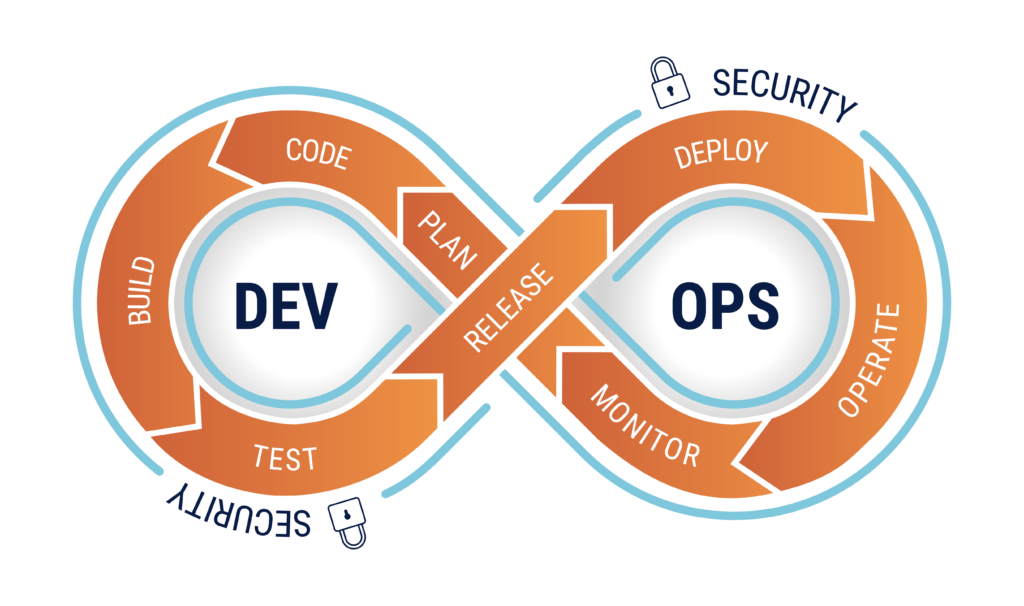Over the years, DevOps has proven to be a powerful approach to software development and delivery. The practice was developed around 2008, when concerned IT operations and software development professionals questioned the traditional software development model that siloed the roles and responsibilities of their respective teams.
Today, the primary aim of DevOps is to enhance collaboration, quality, and speed along the software development lifecycle (SDLC). This blog post is intended to define the practice and provide a few basic ideas for putting DevOps front and center of your application development and delivery environment to help increase innovation.
DevOps automated practices can help your organization put the brakes on burgeoning cloud costs and time spent on software development and production. The use of automation to speed up the SDLC can boost user satisfaction by 50 to 100 percent.2
This will provide more space for your software developers to innovate.
DevOps as Enabler
DevOps practices help modern IT organizations overcome software development obstacles and optimize capabilities such as observability, collaborative expediency, and pipeline automation and acceleration. If an organization has adopted a DevOps practice, the platform that the development team is using should enable the delivery of software updates automatically, continuously, and quickly—while maintaining high quality and security. A fully automated and integrated solution will allow for the development, release, and distribution of software with confidence and speed.
To move forward with innovation, your DevOps team must engage in practices that help reduce time and costs associated with software development and production. Those best practices should include:
Align IT with business goals: DevOps need to enable IT teams to deliver value to customers faster and more frequently by adopting feedback loops, iterative processes, and continuous integration/continuous delivery (CI/CD).
Manage complexity: DevOps should contend with complex services by leveraging microservices, container and serverless architectures, and cloud computing to create and run applications that are scalable, modular, and distributed. To be effective, DevOps must be able to reduce manual errors and improve consistency and reliability with the use of automation tools and practices such as infrastructure-as-code, testing, monitoring, and configuration management.
Integrate security and compliance practices: The DevOps practitioner needs to engage their team in automated security testing, threat modeling, and vulnerability scanning at every stage of the SDLC. Effective DevOps practice promotes security awareness to development and operations teams.
Ever-Evolving, Increasingly Efficient DevOps
The adoption of DevOps best practices and tools can help shorten processes and reduce time along the SDLC pipeline. With all the benefits that these practices and tools can provide, new DevOps capabilities can accelerate the path to innovation by enhancing speed, security, and data governance and by delivering results faster at lower cost.
Going serverless is an innovative approach to deploying software. The serverless market is expected to reach $30 billion by 2030.3 Without the need for servers, DevOps teams can speed up building and running applications and services. Serverless computing boosts faster time-to-market by removing the gap between the “Dev” and the “Ops”. This helps make way for innovation including the generation of code for the DevOps pipeline without the need to manage infrastructure.
Enhanced observability and the integration of AIOps and MLOps can play a significant role in the automation of IT operations and processes. Observability tools, which enable monitoring, tracing, and logging, provide deeper insights into applications and infrastructure that support issue identification and resolution. AIOps and MLOps are two of the hottest trends in DevOps and are predicted to become a $64.44 billion market by 2028.4 As AI and machine learning (ML) mature, they’re proving to be very effective tools that optimize software development and enable pattern recognition, natural language processing (NLP), and sentiment analysis.5 AI-driven tools can assist in identifying potential issues, automating rote tasks, and enhancing efficiency and security across the SDLC pipeline.
Security Across the SDLC Pipeline
As DevOps continues to evolve and mature, integrating security into every stage of the SDLC pipeline can influence the flow of innovation. With the rise of cyberthreats, the consolidation of a complete security practice should be prioritized. Automated, continuous security testing, compliance checks, threat modeling, and vulnerability scanning are some of the key practices that DevOps can use to ensure security and compliance without slowing down the process.
One of the objectives in producing and delivering quality software is to make it as resistant to security risks as possible. The integration of security into DevOps practices resulting in DevSecOps adds a layer of confidence much earlier in the DevOps process.6 Here are some of the key DevSecOps practices that help ensure security across the DevOps CI/CD pipeline:
- Automation of security processes
- Implementation of continuous testing
- Prioritization of remediation over detection
- Creation of a culture around secure coding principles
The adoption of a comprehensive security strategy enabled by DevSecOps within the broader DevOps practice can empower developers to identify and mitigate issues before they become actual problems in production.

Accelerate Processes to Accelerate Innovation
The recent rise of low-code/no-code (LC/NC) platforms are allowing developers and non-developers alike to create applications without writing code—or by writing very little of it—using graphical user interfaces (GUIs), drag-and-drop components, and pre-built templates or recipes. Users of LC/NC can also create APIs, integrate platforms, and manage workflows with little or no coding knowledge.
LC/NC platforms help DevOps teams accelerate development, reduce complexity, reduce errors (although continuous testing is advised), and enable innovation, while ensuring quality and at least some level of security.
Although there are additional DevOps accelerators of innovation, the examples presented in this blog post can certainly aid DevOps teams in their day-to-day tasks by facilitating better productivity and workflow. DevOps promotes collaboration and communication between developers and operations teams at all stages of the SDLC. The whole idea of DevOps is founded on the goal of creating and delivering applications faster, more efficiently, and more reliably. The process is always in flux as new capabilities arise to accelerate processes in the race to innovation. It can only get better!
To Learn More
To learn more about what we do at Prowess Consulting, view our latest research and follow us on LinkedIn.
1 Gartner. “Gartner Forecasts Worldwide Public Cloud End-User Spending to Reach $679 Billion in 2024.” November 2023.
2 DevOps.com. “Three Trends That Will Transform DevOps in 2023.” February 2023.
3 Simform. “Top 18 DevOps Trends to Watch Out for in 2023 and Beyond.” July 2022.
4 Mordor Intelligence. “AIOps Platforms Market – Size & Share Analysis – Growth Trends & Forecasts (2023-2028).” 2023.
5 DevOps.com. “Best of 2022: 6 Top Technology Trends to Watch.” December 2022.
6 DevOps.com. “The Differences Between DevOps, DevSecOps and SRE.” August 2023.
Related Posts

Do You Know How to Choose the Right Hardware-Based Accelerator?
We believe that any data-centric organization can benefit from using hardware-based accelerators. But the tricky part is choosing the right one for the job. It

So Long to 2022
Before we say “So Long!” to 2022 and usher in the New Year, we at Prowess want to share our successes from this past year

Is Your App as Smart as It Could Be?
We believe that any data-centric organization can benefit from using hardware-based accelerators. But the tricky part is choosing the right one for the job. It
